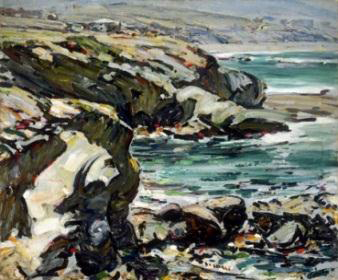
Clarence Hinkle
American, 1880-1960
Coast Line, Laguna, 1924 ca.
oil on canvas
30 x 36 in.
SBMA, Gift of Mabel Bain Hinkle
1961.18

Clarence Hinkle, Self-Portrait with Bowler Hat, ca. 1900-1901(SBMA)
COMMENTS
Clarence Hinkle was an early twentieth-century artist who radiated the spirit of modernism. Born in Auburn, California in 1880, Hinkle was one of only a few native Californians of his generation who became nationally known artists. His education was broad and far-reaching, beginning with studies at the Crocker Art Gallery in Sacramento and the California School of Design in San Francisco. He continued his studies in the East at the Art Students League then at the Pennsylvania Academy of the Fine Arts in Philadelphia. There he was the recipient of the Cresson traveling scholarship, which afforded him the opportunity to travel and study in Europe. He spent six years abroad, living for a few years in Holland and visiting France, England, Spain, and Italy.
Hinkle was an artist in love with the act of painting, seeing every thing with an analytical eye as to how best to interpret the subject in paint. This is evident in the different approaches he took with each subject, whether landscape, portrait, or still life. From his student years up until about 1924 he worked in a style rooted in American impressionism. But in the 1920s he developed a more abstract, gestural style with an emphasis on line that shows the influence of expressionism. Seen close-to, many of his small panel paintings from this period appear as pure abstraction, but when viewed with some distance the dashes and dabs of pigment coalesce into a recognizable image. In the years after his move to Santa Barbara [where he built a home on Hillcrest Road atop the Riviera,] Hinkle abandoned his abstract, linear style in favor of a more literal interpretation of the landscape. Yet these works too show him applying paint with expressive and energetic strokes. Hinkle painted still lifes, portraits, and figural works that also reflect his growth as an artist from impressionist to modernist. As a member of the California Water Color Society, he painted watercolors, most of them quickly rendered with areas left bare of pigment, allowing the white paper to form part of the composition.
- ArtDaily, November 1, 2012
